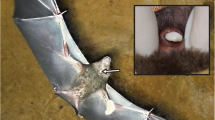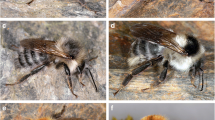Abstract
With a combination of dichloromethane extraction and analysis by gas chromatography–mass spectrometry (GC-MS), we found 39 compounds (corresponding to 38 GC peaks) in the anogenital gland secretion (AGS) of captive adult giant pandas, Ailuropoda melanoleuca, during the non-mating season. In addition to indole, squalene, and some of the straight-chain fatty acids that had been characterized previously from the AGS of giant pandas, we identified several new compounds such as decenal, two isomers of decadienal, phenylacetic acid, 5-methylhydantoin, hydroquinone, phenylpropanoic acid, and erucic acid. Quantitative comparison of the relative abundances of the 20 main GC peaks revealed that 5-methylhydantoin, indole, and erucic acid are putative female pheromones, whereas squalene and hydroquinone are putative male pheromones. In addition to the presence of a few individual-specific compounds, the relative abundances of most of the 21 constituents varied more among individuals than within individuals. This suggests that individual identity might be coded in both digital and analog form. The chemical composition of different AGS samples from the same pandas consistently displayed a minimum cluster distance, much smaller than that between samples from different individuals in a hierarchical linkage cluster (average linkage) dendrogram. Our results indicate that the AGS might contain an “odor fingerprint.” Although putative sex pheromones such as squalene and erucic acid should be assessed further by bioassay, our study suggests that synthetic chemosignals might be useful in modulating the behavior and physiology of giant pandas.


Similar content being viewed by others
References
Agilent Technologies 2002. Mass Spectral Libraries, NIST. Palo Alto, CA, USA.
Andersen, K. F., and Vulpius, T. 1999. Urinary volatile constituents of the lion, Panthera leo. Chem. Senses 24:179–189.
Brown, R. E., and MacDonald, D. W. 1985. Social Odours in Mammals. Oxford University Press, Oxford, UK.
Clapperton, B. K., Minot, E. O., and Crump, D. R. 1988. An olfactory recognition system in the ferret Mustela furo L. (Carnivora: Mustelidae). Anim. Behav. 36:541–553.
El-Sayed, A. M. 2005. The Pherobase: Database of insect pheromones and semiochemicals. <http://www.pherobase.com/database/compound>.
Epple, G., Golob, N. F., and Smith, A. B. I. 1979. Odor communication in the tamarin Saguinus fuscicollis (Callitrichidae): Behavioral and chemical studies, pp. 117–130, in F. J. Ritter (ed.). Chemical Ecology: Odour Communication in Animals. Elsevier, Amsterdam.
Ferkin, M. H., Sorokin, E. S., Johnston, R. E., and Lee, C. J. 1997. Attractiveness of scents varies with protein content of the diet in meadow voles. Anim. Behav. 53:133–141.
Gassett, J. W., Wiesler, D. P., Baker, A. G., Osborn, D. A., Miller, K. V., Marchinton, R. L., and Novotny, M. 1996. Volatile compounds from interdigital gland of male white-tailed deer (Odocoileus virginianus). J. Chem. Ecol. 22:1689–1696.
Gosden, P. E., and Ware, G. C. 1976. The aerobic flora of the anal sac of the red fox (Vulpes vulpes). J. Appl. Bacteriol. 41:271–275.
Hagey, L., and Macdonald, E. 2003. Chemical cues identify gender and individuality in giant pandas (Ailuropoda melanoleuca). J. Chem. Ecol. 29:1479–1488.
Liu, D., Fang, J., Sun, R., Zhang, G., Wei, R., and Zhang, H. 1998. Behavioral comparison in individuals of different sexual ability in giant panda (Ailuropoda melanoleuca). Acta Zool. Sin. 44:27–34.
Liu, D., Zhang, G., Wei, R., Zhang, H., Fang, J., and Sun, R. 2002. The effects of sex and age on the behavior of captive giant pandas (Ailuropoda melanoleuca). Acta Zool. Sin. 48:585–590.
Liu, D., Wang, Z. P., Tian, H., Yu, C. Q., Zhang, G. Q., Wei, R. P., and Zhang, H. M. 2003. Behavior of giant pandas (Ailuropoda melanoleuca) in captive conditions: Gender differences and enclosure effects. Zoo Biol. 22:77–82.
Liu, D., Zhang, G., Wei, R., Zhang, H., Fang, J., and Sun, R. 2005. Behavioral responsiveness of captive giant pandas (Ailuropoda melanoleuca) to substrate odors from conspecifics of the opposite sex, pp. 101–109, in R. T. Mason, M. P. LeMaster, and D. Müller-Schwarze (eds.). Chemical Signals in Vertebrates 10Springer, New York.
Liu, D., Yuan, H., Tian, H., Wei, R. P., Zhang, G. Q., Sun, L., and Sun, R. Y. 2006. Do the anogenital gland secretions of giant panda code for their sexual ability? Chin. Sci. Bull. 51:1986–1995.
Mason, R. T., Fales, H. M., Jones, T. H., Pannell, L. K., Chinn, J. W., and Crews, D. 1989. Sex pheromones in snakes. Science 245:290–293.
Mason, R. T., and Gutzke, W. H. N. 1990. Sex recognition in the leopard gecko, Eublepharis macularius (Sauria: Gekkonidae): Possible mediation by skin-derived semiochemicals. J. Chem. Ecol. 16:27–36.
Novotny, M., Ma, W., Zidek, L., and Daev, E. 1999. Recent biochemical insights into puberty acceleration, estrus induction, and puberty delay in the house mouse, pp. 99–116, in R. E. Johnston, D. Müller-Schwarze, and P. W. Sorensen (eds.). Advances in Chemical Signals in Vertebrates. Kluwer, New York.
Schaller, G. B., Hu, J., Pan, W., and Zhu, J. 1985. The Giant Pandas of Wolong. University of Chicago Press, Chicago, IL.
Singer, A. G., Beauchamp, G. K., and Yamazaki, K. 1997. Volatile signals of the major histocompatibility complex in male mouse urine. Proc. Natl. Acad. Sci. U. S. A. 94:2210–2214.
SPSS Inc. 1999. SPSS for Windows. Release 10.0.1. Chicago, IL.
Sun, L., and Müller-Schwarze, D. 1998a. Anal gland secretion codes for family membership in the beaver. Behav. Ecol. Sociobiol. 44:199–208.
Sun, L., and Müller-Schwarze, D. 1998b. Anal gland secretion codes for relatedness in the beaver, Castor canadensis. Ethology 104:917–927.
Swaisgood, R. R., Lindburg, D. G., and Zhou, X. 1999. Giant pandas discriminate individual differences in conspecific scent. Anim. Behav. 57:1045–1053.
Swaisgood, R. R., Lindburg, D. G., and Owen, M. A. 2000. The effects of sex, reproductive condition and context on discrimination of conspecific odours by giant pandas. Anim. Behav. 60:227–237.
Tian, H., Wei, R. P., Zhang, G. Q., Sun, R. Y., and Liu, D. Z. 2007. Age differences in behavioral responses of male giant pandas to chemosensory stimulation. Zoological Research 28:134–140.
White, A. M., Swaisgood, R. R., and Zhang, H. 2002. The highs and lows of chemical communication in giant pandas (Ailuropoda melanoleuca): Effect of scent deposition height on signal discrimination. Behav. Ecol. Sociobiol. 51:519–529.
White, A. M., Swaisgood, R. R., and Zhang, H. 2003. Chemical communication in the giant panda (Ailuropoda melanoleuca): The role of age in the signaller and assessor. J. Zool. Lond. 259:171–178.
White, A. M., Swaisgood, R. R., and Zhang, H. 2004. Urinary chemosignals in giant pandas (Ailuropoda melanoleuca): Seasonal and developmental effects on signal discrimination. J. Zool. Lond. 264:231–238.
Xie, Z., and Gipps, J. 2005. The International Studbook for Giant Panda (Ailuropoda melanoleuca). Chinese Association of Zoological Gardens, Beijing.
Yuan, H., Liu, D., Sun, L., Wei, R. P., Zhang, G. Q., and Sun, R. Y. 2004. Anogenital gland secretions code for sex and age in the giant panda, Ailuropoda melanoleuca. Can. J. Zool. 82:1596–1604.
Zhan, X. J., Li, M., Zhang, Z. J., Goossens, B., Chen, Y. P., Wang, H. J., Bruford, M. W., and Wei, F. W. 2006. Molecular censusing doubles giant panda population estimate in a key nature reserve. Curr. Biol. 16:R451–R452.
Zhang, J. X., Ni, J., Ren, X. J., Sun, L. X., Zhang, Z. B., and Wang, Z. W. 2003. Possible coding for recognition of sexes, individuals and species in anal gland volatiles of Mustela eversmanni and M. sibirica. Chem. Senses 28:381–388.
Zhang, J. X., Soini, H. A., Bruce, K. E., Wiesler, D., Woodley, S. K., Baum, M. J., and Novotny, M. V. 2005. Putative chemosignals of the ferret (Mustela furo) associated with individual and gender recognition. Chem. Senses 30:727–737.
Zhang, J. X., Rao, X. P., Sun, L., Zhao, C., and Qin, X. 2007a. Putative chemical signals about sex, individuality and genetic background in the preputial gland and urine of the house mouse (Mus musculus). Chem. Senses 32:293–303.
Zhang, J. X., Rao, X. P., Zhao, C., Liu, X., and Qin, X. 2007b. Possible information about gender and individual recognition coded by insect pheromone analogs in the preputial glands in male Brandt’s voles, Lasiopodomys brandtii. Acta Zool. Sin. 53:616–624.
Acknowledgments
We are grateful to Dr. Steven J Seybold and the anonymous reviewers who gave us many helpful suggestions and comments. This work was supported by grants from NSFC (Nos. 30470233 and 30670268); International Cooperative Giant Panda Projects of State Forestry Administration, China (nos. WH0306 and WH0309) and International Partnership Project of Innovative Research, Chinese Academy of Science (CXTDS2005-4).
Author information
Authors and Affiliations
Corresponding author
Rights and permissions
About this article
Cite this article
Zhang, JX., Liu, D., Sun, L. et al. Potential Chemosignals in the Anogenital Gland Secretion of Giant Pandas, Ailuropoda melanoleuca, Associated with Sex and Individual Identity. J Chem Ecol 34, 398–407 (2008). https://doi.org/10.1007/s10886-008-9441-3
Received:
Accepted:
Published:
Issue Date:
DOI: https://doi.org/10.1007/s10886-008-9441-3




